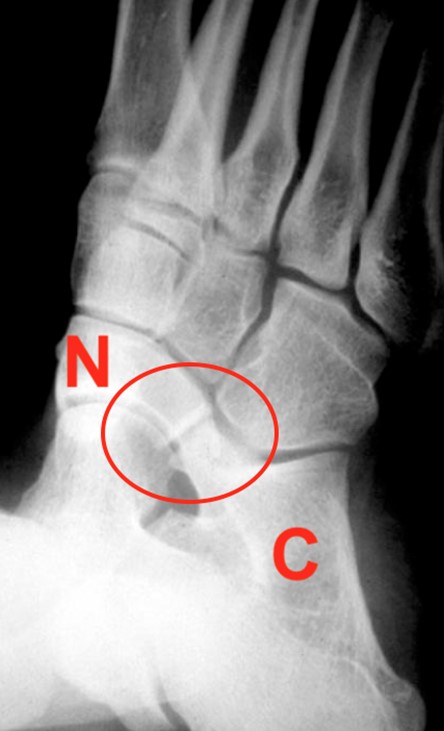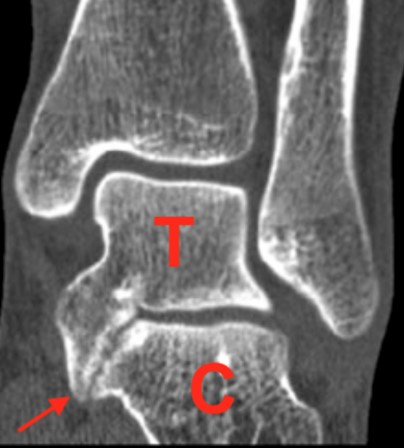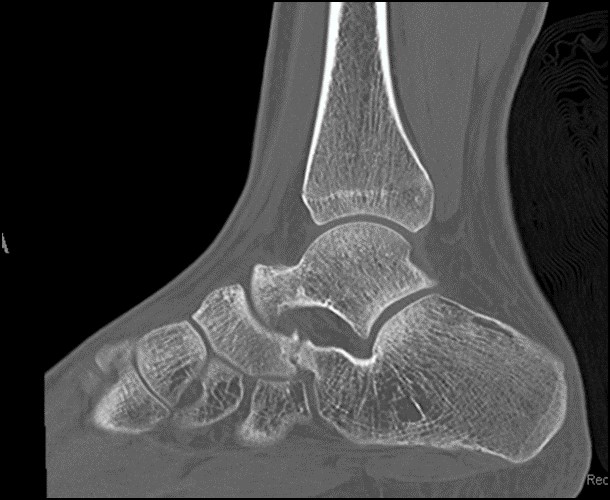Description
The human foot is made of 26 different bones! There are many joints that connect the bones and allow motion between the bones. These bones and joints in the foot provide support while also allowing movement for activities such as jumping and dancing.
A tarsal coalition is when the joint between two or more bones in the foot does not develop properly. Instead of a joint, there is either solid bone (bony coalition) or fibrous material (fibrous coalition). The bony or fibrous coalition does not move normally, and the bones are “stuck together”. This coalition is likely present at birth but usually does not cause problems until the teenage years.
The two most common tarsal coalitions are calcaneonavicular coalitions and talocalcaneal coalitions. These terms refer to the specific bones that are stuck together (calcaneonavicular – calcaneus and navicular bone, talocalcaneal – talus and calcaneus bone).

Radiograph shows a calcaneonavicular coalition (red circle) between the calcaneus (red C) and the navicular (red N).

CT scan demonstrates a talocalcaneal coalition (red arrow) between the calcaneus (red C) and the talus (red T).
Tarsal coalitions can be associated with certain rare genetic and developmental conditions, but most are isolated and are not associated with other problems.
Symptoms
Tarsal coalitions can cause pain with activities such as running, jumping, or hiking. Some children with coalitions experience recurrent ankle sprains. The foot in children with tarsal coalitions is usually flat. Many children and teenagers have flexible flat feet (
link), but flat feet associated with tarsal coalitions are rigid. An easy way to tell the difference between flexible flat feet (
link) and rigid flat feet is to look at the foot when the child is standing up on his or her tiptoes. If the foot has a good arch when standing on their tiptoes, then the flat foot is flexible. If the foot is still flat when the child is on their tiptoes, or if the child has difficulty standing on his or her tiptoes, then the flat foot may be rigid. A rigid flatfoot may be a sign of a tarsal coalition.
Examination
Your doctor will discuss your medical history and examine your feet. She/he will watch you walk and check the range of motion of the foot and ankle. Your doctor will watch how you stand up on your toes.
X-rays and Other Tests
The first test to look for a tarsal coalition is an x-ray of the foot. A CT scan or an MRI scan can also help look at the structure of the foot, but it is not always necessary for diagnosis or treatment.

CT scan shows a calcaneonavicular coalition (red arrow) between the calcaneus (red C) and the navicular (red N).
Treatment
Many people with tarsal coalitions do not have pain or problems, and many children with tarsal coalitions can be treated without surgery. If your child has a coalition and is having pain, often times rest is all that is needed. Shoe inserts and ankle strengthening exercises can also help. Casts can be used in more severe cases.
If nonsurgical treatment does not work, surgery can be considered. The exact type of surgery depends on the size and location of the coalition. Most of the time, the surgery will remove the coalition and insert fat or muscle between the bones. This will help prevent the coalition from coming back. Very large coalitions can be difficult to remove completely. In these cases, more complex surgery may be needed.
Outcomes
Some patients with tarsal coalition never have symptoms. Other patients will get better with nonoperative treatment such as rest, casting, orthotics, or strengthening exercises. When surgery is necessary because of continued pain, the majority of patients improve after surgery.
More Information
Q: I think my child has a tarsal coalition. When should I see the doctor?
If your child is having foot pain and has flat feet, sometimes just rest and over-the-counter shoe inserts may be all that is needed. Most tarsal coalitions do not need surgery. If the pain is severe, if the pain is worsening, or if you suspect that something else may be going on, then a timely evaluation by a physician is recommended.
Q: Is the pain coming from the coalition or the flatfoot?
A coalition limits movement of the bones in the feet. This can create abnormal stress on the other bones of the foot. Taking out the coalition usually relieves pain, even though the flatfoot remains.
Q: Will removing the coalition fix the flatfoot?
Removing the coalition provides more mobility and flexibility to the foot, but usually does not change the flatfoot that is already there. Other procedures are necessary if the goal is to correct the flatfoot.
Q: Will removing the coalition relieve the pain?
Removing the coalition most commonly improves the flexibility and motion of the foot. Most patients experience pain relief after recovering from the surgery.
Q: Will removing the coalition make my child run better?
Removing the coalition typically improves the motion of the foot and allows the patient to have a more normal walk. The surgery does not specifically improve the physical abilities of the patient.
Q: Will my child need orthotics after surgery?
This will be determined by your doctor. Well-structured shoes or over-the-counter arch supports could be recommended.

 POSNA.org
POSNA.org


